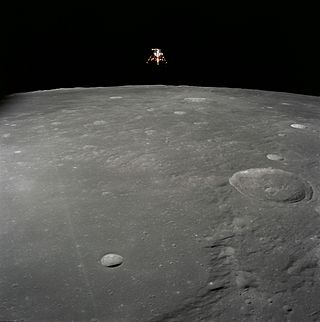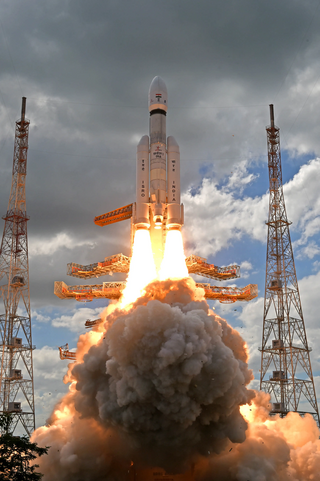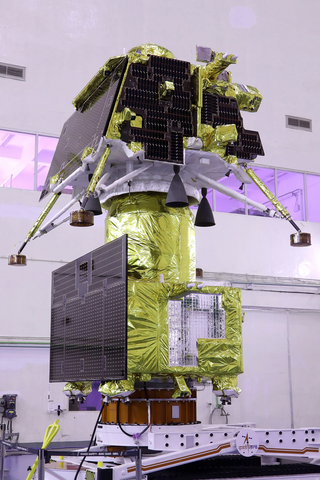Related Research Articles

A lander is a spacecraft that descends towards, then comes to rest on the surface of an astronomical body other than Earth. In contrast to an impact probe, which makes a hard landing that damages or destroys the probe upon reaching the surface, a lander makes a soft landing after which the probe remains functional.

Indian Space Research Organisation is the national space agency of India. It operates as the primary research and development arm of the Department of Space (DoS), which is directly overseen by the Prime Minister of India while the Chairman of ISRO also acts as the executive of DoS.

Chandrayaan-1 was the first Indian lunar probe under the Chandrayaan programme. It was launched by the Indian Space Research Organisation (ISRO) in October 2008, and operated until August 2009. The mission included an orbiter and an impactor. India launched the spacecraft using a PSLV-XL rocket on 22 October 2008 at 00:52 UTC from Satish Dhawan Space Centre, at Sriharikota, Andhra Pradesh. The mission was a major boost to India's space program, as India researched and developed indigenous technology to explore the Moon. The vehicle was inserted into lunar orbit on 8 November 2008.

A Moon landing or lunar landing is the arrival of a spacecraft on the surface of the Moon, including both crewed and robotic missions. The first human-made object to touch the Moon was Luna 2 in 1959.

The physical exploration of the Moon began when Luna 2, a space probe launched by the Soviet Union, made a deliberate impact on the surface of the Moon on September 14, 1959. Prior to that the only available means of exploration had been observation from Earth. The invention of the optical telescope brought about the first leap in the quality of lunar observations. Galileo Galilei is generally credited as the first person to use a telescope for astronomical purposes; having made his own telescope in 1609, the mountains and craters on the lunar surface were among his first observations using it.

Mylswamy Annadurai is an Indian scientist working as vice president for Tamil Nadu State Council for Science and Technology, Chairman, Board of Governors, National Design and Research Forum. He is often dubbed as the "Moon Man of India".

Chandrayaan-2 is the second lunar exploration mission developed by the Indian Space Research Organisation (ISRO) after Chandrayaan-1. It consists of a lunar orbiter, the Vikram lunar lander, and the Pragyan rover, all of which were developed in India. The main scientific objective is to map and study the variations in lunar surface composition, as well as the location and abundance of lunar water.

The Moon Impact Probe (MIP) developed by the Indian Space Research Organisation (ISRO), India's national space agency, was a lunar probe that was released by ISRO's Chandrayaan-1 lunar remote sensing orbiter which in turn was launched, on 22 October 2008, aboard a modified version of ISRO's Polar Satellite Launch Vehicle. It discovered the presence of water on the Moon.

A lunar rover or Moon rover is a space exploration vehicle designed to move across the surface of the Moon. The Apollo program's Lunar Roving Vehicle was driven on the Moon by members of three American crews, Apollo 15, 16, and 17. Other rovers have been partially or fully autonomous robots, such as the Soviet Union's Lunokhods, Chinese Yutus, Indian Pragyan, and Japan's LEVs. Five countries have had operating rovers on the Moon: the Soviet Union, the United States, China, India, and Japan.

The Chandrayaan programme also known as the Indian Lunar Exploration Programme is an ongoing series of outer space missions by the Indian Space Research Organization (ISRO) for the exploration of the Moon. The program incorporates a lunar orbiter, an impactor, a soft lander and a rover spacecraft.

Jawahar Point or Jawahar Sthal is the site near the Shackleton Crater where the Moon Impact Probe (MIP) of the Chandrayaan-1 hard landed on lunar surface on 14 November 2008. The name was suggested by India's former President A. P. J. Abdul Kalam as the MIP touched the Moon on the birth anniversary of India's first prime minister Jawaharlal Nehru.

Sreedhara Panicker Somanath is an Indian aerospace engineer serving as the chairman of the Indian Space Research Organisation (ISRO). Under his chairmanship, ISRO carried out the third Indian lunar exploration mission named Chandrayaan-3. The lander named Vikram and the rover named Pragyan landed near the lunar south pole region on 23 August 2023 at 18:04 IST, making India the first country to successfully land a spacecraft near the lunar south pole and the fourth country to demonstrate soft landing on the Moon.

Pragyan is a lunar rover that forms part of Chandrayaan-3, a lunar mission developed by the Indian Space Research Organisation (ISRO).
The Lunar Polar Exploration Mission (LUPEX) is a planned joint lunar mission by the Indian Space Research Organisation (ISRO) and Japan Aerospace Exploration Agency (JAXA). The mission would send an uncrewed lunar lander and rover to explore the south pole region of the Moon no earlier than 2026. It is envisaged to explore the permanently shadowed regions on the Moon. JAXA is likely to provide the H3 launch vehicle and the rover, while ISRO would be providing the lander.

Chandrayaan-3 is the third mission in the Chandrayaan programme, a series of lunar-exploration missions developed by the Indian Space Research Organisation (ISRO). The mission consists of a Vikram lunar lander and a Pragyan lunar rover was launched from Satish Dhawan Space Centre on 14 July 2023. The spacecraft entered lunar orbit on 5 August, and India became the 1st country to touch down near the lunar south pole, at 69°S, the southernmost lunar landing on 23 August at 18:03 IST, made ISRO the fourth space agency to successfully land on the Moon, after Roscosmos, NASA, and the CNSA. The lander was not built to withstand the cold temperatures of the lunar night, and sunset over the landing site ended the surface mission twelve days after landing. The propulsion module, still operational, transited back to a high Earth orbit from lunar orbit on 22 November 2023 for continued scientific observations of Earth.
Chandrayaan-4 is a planned lunar sample-return mission and the fourth mission in the Chandrayaan programme, a series of lunar-exploration missions developed by the Indian Space Research Organisation (ISRO). The mission is currently under conceptualisation phase and is slated for launch no earlier than 2028.
Shivashakti or Sivasakthi is a compound name in which Shiva is the identified masculine consciousness and Shakti is the identified feminine divine energy. It may refer to:

Statio Shiv Shakti or Shiv Shakti Point is the landing site of Chandrayaan-3, the third lunar mission of Indian Space Research Organisation (ISRO). The mission's lander Vikram and rover Pragyan landed 600 km from the south pole of the Moon on 23 August 2023. The landing site was named on 26 August 2023 at the ISTRAC headquarters in Bengaluru, after India became the fourth nation to make a successful soft landing on the Moon and also becoming the first country that landed on the lunar south pole. Statio Shiv Shakti is located at the coordinates 69.373°S 32.319°E and lies between the lunar craters Manzinus C and Simpelius N. It has been proposed that the upcoming sample-return mission Chandrayaan-4 also land near the point.

Pragyan is a lunar rover that forms part of Chandrayaan-2, a lunar mission developed by the Indian Space Research Organisation (ISRO). The rover was launched as part of Chandrayaan-2 on 22 July 2019 and was destroyed with its lander, Vikram, when it crashed on the Moon on 6 September 2019.
References
- ↑ "Modi in Bengaluru Live Updates: Touchdown point of Vikram lander will be known as 'Shivshakti', says PM". The Indian Express. 2023-08-25. Retrieved 2023-08-26.
- ↑ "Mission homepage". Indian Space Research Organisation.
- ↑ "Chandrayan-2 Launch Rescheduled on 22 July 2019, AT 14:43 HRS". Indian Space Research Organisation. 18 July 2019. Archived from the original on 30 August 2019. Retrieved 18 July 2019.
- ↑ "Chandrayaan 3 touchdown spot named 'Shiv Shakti', 'Tiranga' for Chandrayaan 2". Hindustan Times. 26 August 2023. Retrieved 27 August 2023.
- ↑ "Tiranga and Shiv Shakti: India names two areas on Moon related to Chandrayaan missions". ABP News. 26 August 2023. Retrieved 27 August 2023.
